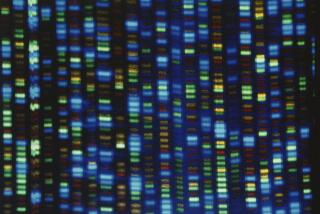Network Urged for Cord Blood
- Share via
The collection and storage of umbilical cord blood -- a fast-growing alternative to bone marrow transplants for chemotherapy patients -- should be coordinated by a government network to increase availability, a national advisory panel concluded in a report released Thursday.
Congress has set aside $19 million to subsidize public cord-blood banks and organize the program.
The goal is to add 100,000 units to boost the odds of finding good genetic matches that can be used in patients.
The panel also recommended that the Food and Drug Administration move cord blood from its current status as an experimental therapy to a licensed therapeutic product.
The report is “a real validation that cord blood is ready for federal funding,” said Dr. Jeffrey Chell, chief executive of the National Marrow Donor Program, which maintains a registry of cord-blood units from 14 public banks.
The recommendations were created by the Institute of Medicine, part of the National Academy of Sciences.
Cord blood, which is harvested after births, contains stem cells that can generate a variety of blood cells. The cells are most commonly used to rebuild a patient’s immune system after chemotherapy.
Cells surgically taken from bone marrow donors have long fulfilled this role.
But cord-blood stem cells have become an attractive alternative because they are less mature than marrow cells and therefore do not require a perfect genetic match to be used in transplantation.
Cord-blood cells have been used since 1988 to treat about 6,000 patients. About two-thirds were children suffering from leukemia and other blood diseases. Cord blood is used less frequently in adults because a single umbilical cord usually does not contain enough cells.
Currently, the system for procuring cord blood is fragmented. There are about 20 public cord-blood banks in the United States, most connected with hospitals.
With no single registry for cord blood, searches can be tedious.
The biggest registry is run by the National Marrow Donor Program, but it does not include the New York Blood Center, which has the largest single supply of frozen cord blood -- 27,000 units.
In addition, there are no government standards to ensure that the cells are collected, processed and stored properly.
Dr. John Wagner, clinical director of the blood and bone marrow transplant program at the University of Minnesota and a member of the panel that produced the report, said that out of about 180,000 units of cord blood stored in public banks worldwide, about 50,000 of them could be used for transplants. The most common problem with a sample is that it contains too few cells to be usable.
The study recommended the creation of a national center to allow doctors to easily search for matches and report the results of the transplants they perform.
The program also would seek to increase the national inventory to 150,000 units, with 90% used for transplantation and 10% for research.
The new report paid little attention to the expanding industry of private cord-blood banks, which market to pregnant women and charge an average of $1,500 -- plus $150 a year -- to collect and store cord blood in case their children ever need it.
Only a few transplants have been performed using blood from these banks.







